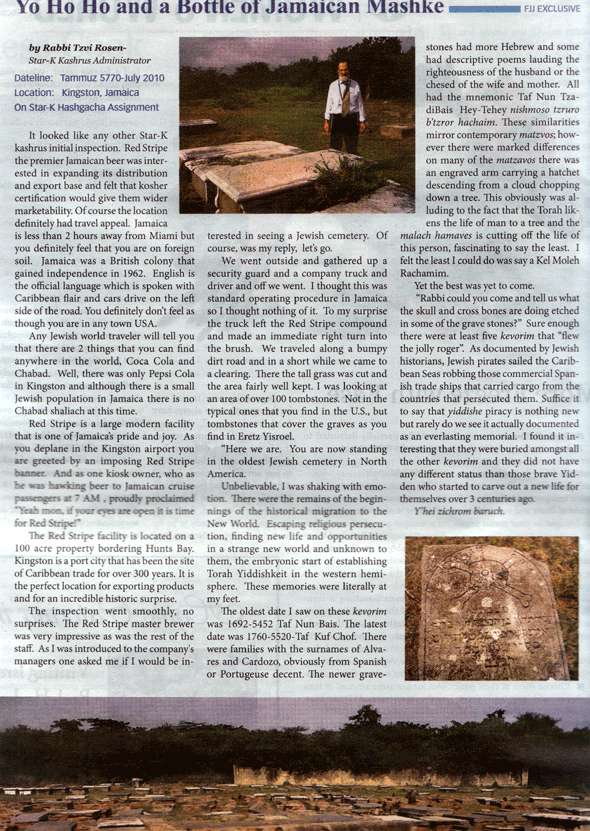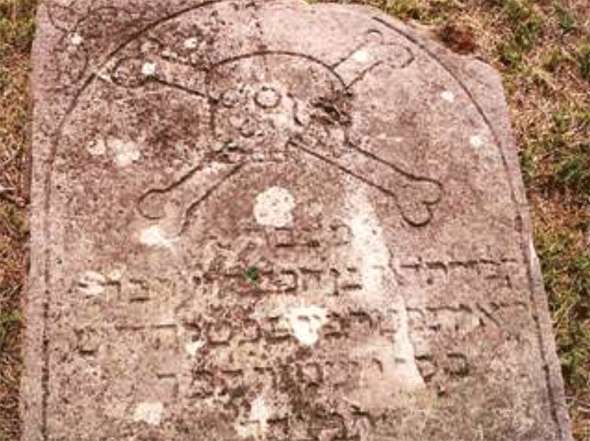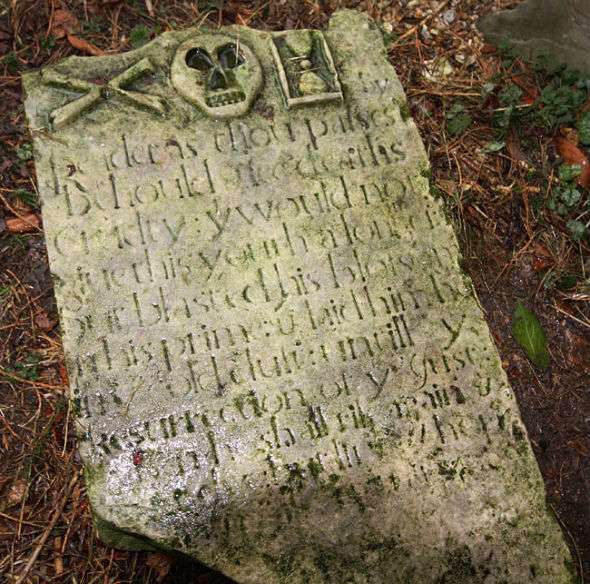
The author was taken to visit a very old Jewish cemetery (by North American standards - a 300 year old Jewish cemetery is not old in the Old World). As you can see, he was charmed and impressed by five Jewish graves that seem to have the fabled Jolly Roger symbol of piracy (skull and crossbones). Note that his tour guide did not tell him that is what those symbols meant - not that it would matter too much if they did. Rather, he was asked by them "Rabbi could you come and tell us what the skull and cross bones are doing etched in some of the grave stones?"

Detail:

Knowing (or sort of remembering?) that Jewish buccaneers have been "documented by Jewish historians," he assumed as most people would that these were graves of Jewish pirates. See here for example. It's the same grave. Of course it is "interesting that they were buried amongst all the other kevorim and they did not have any different status than those brave Yidden who started to carve out a new life for themselves over 3 centuries ago." I know that pirates are positively charming. I mean, who doesn't love pirates? They had parrots? They said "yaaarr." Still I'm not a huge fan of marauding and murder, so I was thinking that perhaps no evidence was shown that these graves are the graves of pirates. Thus, we also don't have to ask why the Jews buried them in regular graves in the cemetery, as opposed to treating them like criminals - to the extent that they'd even etch the symbols of their trade onto their matzevah (grave stone), stamped with the wish that their souls be bound in the bonds of eternal life - תנצבה?
Although at first glance it seems like a reasonable assumption, this is because the skull and bones survive to the present consciousness only as symbols of piracy. However, actually they were symbols of death, and in the period in question they were often carved on tombstones of fine, upstanding people. The practice is Memento Mori, or a reminder of mortality. It's like wearing a kittel on Yom Kippur.
There are many examples which you can find quite easily. For example, this blog has a beautiful and haunting picture of the following grave of one Ellis Penson, deceased at age 23 in 1720:

Since it's hard to read, here is the transcript posted at that blog:
Reader as thou passes by
Behould thee death’s
Cruelty: yt would not
give this youth a longer time
but blasted his blossom
in his prime: it hid him here
in mold duli: untill ye
resurrection of ye Just
then he shall rise again
etc
He certainly was no pirate. I should also take the opportunity to note that "ye" (often mangled in quaint stores with names like "Ye Olde Something-or-other Shoppe") is the word "the." It is not a Y, but a symbol that is an abbrevation for "th," derived from the third letter of the Saxon alphabet, thorn with a superscript e: þe.
 See here.
See here.Years ago I posted a picture of Judah Monis's grave at English Hebraica:

In a post in 2009 called They don't make Hevra Kadishah guidebooks like they used to I made the obvious joke: pirates of the kadishah.

Amsterdam, 1810 - link.
In short, without ANY evidence that these graves are Jewish pirates I would say they were not Jewish pirates. I think the stone is as cool as he does though.





The hourglass was also a common motif on pirate flags of the era (or a skeleton holding an hourglass). The "classic" Jolly Roger, skull and crossbones, was actually rather rare.
ReplyDeletehttp://www.crwflags.com/fotw/flags/pirates.html
Scroll down for links to actual examples.
Jamaica has extremely cool Jewish connections. According to an online clipping that I have from the Canadian Jewish News, 8/27/98, Dr. Anthony MacFarlane, a descendant of the Mendes da Costa family who often went back to the island to lead the High Holy Day services, noted that many Jamaicans are descendants of the out-of-wedlock offspring of Spanish-Portuguese Marranos. Dr. MacFarlane went so far as to claim that Jamaica could be considered a Jewish island "even in its values and thinking."
ReplyDeleteYour readers may also be aware of a much more recent Jewish burial in Jamaica, that of the ger tzedek Yoseph Robinson, who had been murdered in Brooklyn: http://www.aish.com/jw/s/101744148.html.
Yes, Dan, that's what prompted the FJJ to publish this article
ReplyDeleteoldest jewish cemetary? new york's first is from 1656 (no longer extant) and newport's from the 1670s. perhaps he meant the oldest jewish gravestone, or is this really the oldest cemetary?
ReplyDeleteit seems you've shown that absent any evidence to the cotnrary, these were not jewish pirates.
but now that you've brought it up, is there any discussion of jewish piracy in rabbinic literature? (although there were certainly jewish pirates, i think they were more active in financing privateers, which reminds of the jewish kop viagra joke)
It sounds like he meant oldest Jewish cemetery. I think we've established that he's not a historian.
ReplyDeleteIn the original post I conceived in my head I had some lines about privateering as a form of warfare at the time, and thus there is at least some moral ambiguity as to whether or not it was appropriate to treat Jewish pirates with a regular burial, but for some reason I left it out.
There is a book called Jewish Pirates of the Caribbean: How a Generation of Swashbuckling Jews Carved Out an Empire in the New World in Their Quest for Treasure, Religious Freedom--and Revenge - the author even has a web site http://www.jewishpiratesofthecaribbean.com/
I'm guessing this book is the "jewish historians" and the source for the assertion that the "Jewish pirates" did it out of revenge against the Spanish. The book seems fairly responsible for a popular work, but it does seem to sensationalize, calling Samuel Palache "Rabbi," seemingly because the Amsterdam Mahamad once addressed him with an R, which is kind of like nothing. My goodness, the Chasam Sofer must have thought Mendelssohn was mamash a tzadik because he referred to him as Ramad.